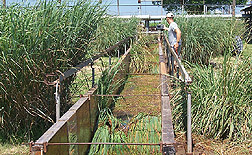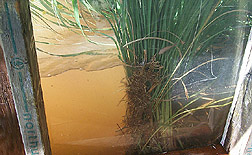Slowing the Flow:
|
|
|
|
Narrow, parallel strips of stiff-stemmed grass, planted along the contour of steep hills, can successfully halt soil erosion caused by flowing water.
"Hedges cause sediment to be deposited upstream of them and reduce erosion and the amount of sediment transported by the flow downstream," says Darrel M. Temple. He is a hydraulic engineer at the ARS Hydraulic Engineering Research Laboratory in Stillwater, Oklahoma. "This reduces sediment delivery to the stream and river system." Temple, working with ARS agronomist Seth M. Dabney at the National Sedimentation Laboratory in Oxford, Mississippi, is evaluating the effectiveness of two types of stiff-grass hedges in controlling this type of soil erosion. |
|
|
"Stiff-grass hedges form a porous barrier to flow that lets water pond upstream. They also diffuse the water over a large area as it flows through them," says Dabney. "Over time, soil deposited above contour hedges may form stable terraces."
Dabney has assessed the beneficial role of grass hedges in controlling erosion from croplands for several years. "Although stiff-grass hedges are a valuable conservation tool, little data on their hydraulic behavior is available. That's because much of the research on flow resistance of grasses doesn't apply to stiff grasses," says Dabney. "Stiff-grass hedges are designed to function with water flowing through them rather than over them." In the field and at flume facilities at Stillwater, the two scientists decided to study the hydraulic behavior of two types of stiff-grass hedges: switchgrass,Panicum virgatum, and eastern gamagrass,Tripsacum dactyloides. They wanted to determine the maximum depth of water upstream that different hedges could withstand without being bent over and overtopped. First, in a test area of the outdoor laboratory, they established 16 hedges in one-, two-, three-, and four-row configurations. For 2 years, they fertilized and irrigated the hedges but didn't cut them. They then put the hedges to the test, discharging more and more water until grasses bent and broke under the flow. Switchgrass proved better adapted to the test environment than gamagrass. It stood erect and held back sediment and water until the water ponded upstream to a depth of 1.4 to 1.6 feet. One- and two-row hedges grew the best and were as resistant as the wider hedges to overtopping, while occupying less area. After the testing, the two scientists cut half of the hedges to remove damaged stems and left the rest undisturbed. While all hedges recovered by the next growing season, clipping or mowing the damaged grass hastened its recovery. "The next 2 years of study will focus on the ability of switchgrass hedges to protect soil from concentrated waterflow on very steep slopes that are already eroded," says Temple. "Our future research will provide more details on how well these hedges perform."—ByHank Becker, formerly with ARS. This research is part of Water Quality and Management, an ARS National Program (#201) described on the World Wide Web at http://www.nps.ars.usda.gov. Darrel M. Temple is with the USDA-ARS Hydraulic Engineering Research Laboratory, 1301 N. Western St., Stillwater, OK 74075-2714; phone (405) 624-4135, ext. 226, fax (405) 624-4136. Seth M. Dabney is with the USDA-ARS National Sedimentation Laboratory, 598 McElroy Dr., Oxford, MS 38655; phone (662) 232-2975, fax (662) 232-2915. |
|
"Slowing the Flow: Grass Hedges To Catch Runaway Soil " was published in the October 2001 issue of Agricultural Research magazine. |
|








